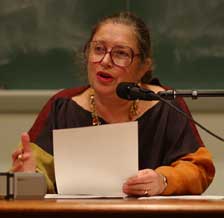 Center of Inquiry speaker Wendy Doniger |
The Mircea Eliade Distinguished Professor of the History of Religions at the University of Chicago, Doniger’s keynote speech addressed whether liberal arts is a distinctively Western concept. Her presentation to a crowd of more than 55 people Thursday night kicked off the second colloquy on liberal arts co-sponsored by the Center of Inquiry in the Liberal Arts at Wabash College and The Phi Beta Kappa Society.
According to Doniger, the classical Hindu approach to education stressed three key areas – the triad of “Dharma,” “Artha” and “Kama.” Representing piety, profit and pleasure, respectively, these concepts were tied together and belonged in balance with each other.
Dharma was the concept of duty, religion and social obligation; Artha, the concept of political power, money and success; and Kama, that of pleasure, desire and music. Found in the first written Hindu text in approximately 1000 B.C.E., Doniger said these concepts represented the multi-faceted nature of the real world. This triad formed the basis of education and liberal arts in classical Hinduism, she said.
Even then, the Hindu recognized that knowledge is a form of power. To control and contain that power, students were permitted to study and learn the most sacred texts in these areas only under the tutelage of a “guru.” This mentor was required to teach the student, translate the sacred texts and assure that the student is not hurt by the power of the text, Doniger said.
The sacred text was preserved through strict oral tradition, she pointed out. The text could not be written, for fear of injuring the text or the writer, she said. However, unlike a modern-day game of telephone, the text was preserved intact through the oral tradition. According to Doniger, “The sacredness of the text demanded that it be preserved with meticulous accuracy. It’s a revealed text and you don’t play fast and loose with revelation.”
The broad range of subjects and the mentor-teacher tradition remind us of how we teach liberal arts today. There was one aspect of the Ancient Indian system that differs greatly from ours, though, Doniger said. Only young men from the upper classes were permitted this course of study. Woman and men of lower castes were allowed training through guilds, but were prohibited from learning Sanskrit, the language of the sacred texts.
This aspect is one Doniger believes we should overlook when considering how to transfer their teaching methods to our classrooms. She quoted Adam Gopnik, who wrote, in reference to some of the Western classics, “A lot of the skill in reading classics lies in reading past them. The obsession with genetic legitimacy and virginity in Shakespeare, the acceptance of torture in Dante, these are not subjects to be absorbed, but things you glide by on your way to the poetry.”
We need to see past the elitism of the Ancient Hindu method, she said, to what is actually taught and said. Furthermore, she said, it is up to the gurus of today to help make that happen.
For more information see: